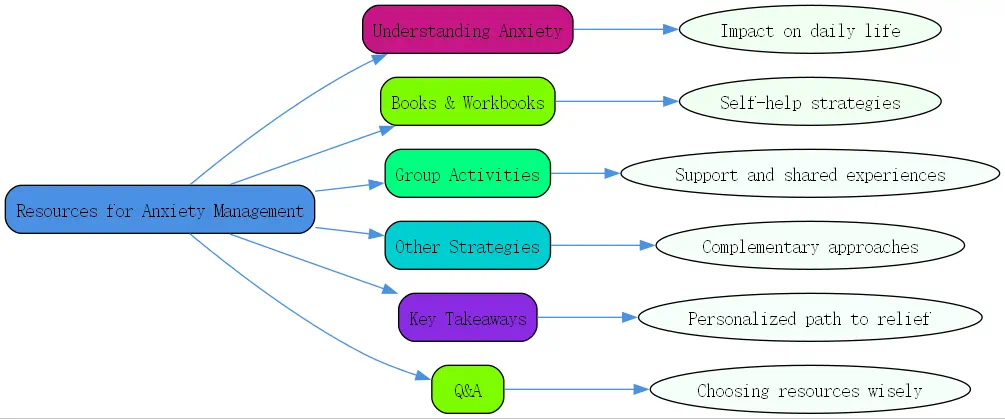Resources for Anxiety Management: A Comprehensive Guide

Anxiety can feel like an unwelcome shadow, clouding daily experiences and hindering happiness. Whether it’s persistent worry, sudden panic, or specific phobias, its effects can be profound. Finding effective resources for anxiety management is a crucial step toward reclaiming peace and well-being. At BrainTalking, we understand the complexities of anxiety and are dedicated to providing clear, evidence-based guidance. This guide explores a range of tools, from insightful books to supportive group activities, helping you build a personalized path to relief.
Understanding Anxiety and Its Impact
Before diving into solutions, it’s helpful to understand what anxiety is and how it manifests. Recognizing its signs and impact is the first step toward effective management.
Defining Anxiety and Anxiety Disorders
Anxiety is a natural human emotion, often characterized by feelings of tension, worried thoughts, and physical changes like increased blood pressure. It’s a normal reaction to stress. However, when anxiety becomes excessive, persistent, and starts interfering significantly with daily life ??work, school, relationships ??it may indicate an anxiety disorder. These disorders encompass conditions like Generalized Anxiety Disorder (GAD), Panic Disorder, Social Anxiety Disorder, specific phobias, and Obsessive-Compulsive Disorder (OCD), each with unique symptoms but often sharing core features of fear and worry.
The Impact of Anxiety on Daily Life and Well-being
Unmanaged anxiety can cast a long shadow. It might prevent you from pursuing opportunities, enjoying social events, or even performing routine tasks. The reference text highlights how nervous, ruminating thoughts can become discouraging, effectively holding you back from happiness and enjoyment. This constant state of unease can lead to fatigue, irritability, difficulty concentrating, sleep problems, and physical symptoms, significantly diminishing overall quality of life and well-being. Recognizing this impact underscores the importance of seeking help.
When to Seek Professional Help
Self-help resources are valuable, but they aren’t always sufficient on their own. If anxiety symptoms are severe, persistent, cause significant distress, or interfere substantially with your ability to function, seeking professional help is essential. Therapists can provide accurate diagnoses, develop tailored treatment plans, and offer evidence-based therapies like Cognitive Behavioral Therapy (CBT) or Dialectical Behavior Therapy (DBT). Psychiatrists can evaluate the need for medication. Many find a combination of professional therapy, medication (if appropriate), and self-help resources to be the most effective approach.
Best Books & Workbooks for Anxiety Management
Workbooks offer a structured, self-paced way to learn and practice anxiety management techniques. They can be used independently or alongside therapy, providing concrete exercises and insights. Here are some of the best books for anxiety management, primarily focusing on workbook formats derived from the reference text:
Top Workbook Recommendations
- The DBT Skills Workbook for Anxiety by Alexander Chapman, Kim Gratz, Matthew Tull & Terence Keane: This comprehensive workbook utilizes a DBT approach, focusing on mindfulness, emotion regulation, distress tolerance, and interpersonal effectiveness. It’s beneficial for diagnosed anxiety disorders but also applicable to everyday anxiety, covering GAD, PTSD, OCD, panic, social anxiety, and stress with clear explanations and practical exercises. Users often report enhanced understanding and reduced anxiety through its interactive format.
- When Panic Attacks by David Burns: Dr. Burns offers over 40 practical exercises centered on cognitive techniques to manage anxiety and panic. The book excels at identifying and challenging negative thought patterns like “”fortune telling”” or “”all-or-nothing thinking.”” While some note an anti-medication perspective, most reviewers praise its clear guidance and helpful exercises for panic, general anxiety, social anxiety, and intrusive thoughts.
- The Mindfulness Workbook for OCD by Jon Hershfield, Tom Corboy & James Claiborn: Combining Cognitive Processing Therapy (CPT) and mindfulness, this workbook specifically targets OCD symptoms. It provides in-depth information on various OCD iterations (e.g., contamination, relationship OCD), including potentially taboo intrusive thoughts. It guides users in increasing self-awareness and modifying unhelpful thinking patterns, proving insightful for managing specific OCD challenges, despite some finding it complex.
- Coping Skills for Kids Workbook by Janine Halloran: Authored by a licensed mental health counselor, this resource provides over 75 exercises designed to help children manage anxiety, stress, and anger. It categorizes coping skills into calming, distraction, physical, and processing types, also offering resources for families and educators. Praised by parents and therapists, it’s adaptable for various ages, equipping kids with practical, usable strategies.
- Pregnancy and Postpartum Anxiety Workbook by Pamela Wiegartz, Kevin Gurtko & Laura Miller: Using a CBT approach, this workbook specifically addresses anxiety during and after pregnancy. It helps identify symptoms, explains how CBT and medication can help, and offers techniques for modifying anxious thoughts and coping with fears via exposure. It covers various disorders like PTSD, OCD, and panic within the perinatal context, including a supportive section for partners. Many parents find its techniques helpful and easy to implement.
- The Shyness and Social Anxiety Workbook for Teens by Jennifer Shannon & Christine Podeswa: This workbook employs CBT and Acceptance and Commitment Therapy (ACT) techniques tailored for teenagers struggling with shyness and social anxiety. It clearly explains social anxiety, differentiates it from shyness, and provides activities to notice, challenge, and cope with anxious thoughts long-term. Users appreciate its informative, concise, and easy-to-read style for breaking down distorted thinking.
- Retrain Your Brain: Cognitive Behavioral Therapy in 7 Weeks by Seth Gillihan: Dr. Gillihan presents a cumulative, seven-week CBT program (adaptable to your own pace) for anxiety and depression. It builds knowledge progressively, covering standard CBT techniques for thoughts and behaviors, alongside time management and goal setting. Reviewers value its accessible language, manageable sections, and effectiveness in fostering self-awareness of thought patterns, despite noting the writing commitment required.
- The Mindfulness and Acceptance Workbook for Anxiety by John P. Forsyth & Georg H. Eifert: This workbook adopts an ACT-driven approach applicable to a wide range of conditions (social anxiety, OCD, PTSD, GAD, phobias, panic). It debunks anxiety myths and promotes mindfulness, acceptance, and reduced anxious avoidance. Focusing on self-compassion and value-driven living, it offers daily exercises. Many find it pairs well with therapy, helping reduce symptom severity with consistent effort.
- Complex PTSD Workbook: A Mind-Body Approach to Regaining Emotional Control and Becoming Whole by Arielle Schwartz: Targeting Complex PTSD, this workbook integrates somatic therapy, CBT, and mind-body perspectives. It explains C-PTSD symptoms (depressive, avoidant, invasive thoughts/behaviors) and offers strategies for assessing trauma, installing positive beliefs, practicing gratitude, and self-care. Buyers find it a valuable starting point for therapy, particularly for addressing childhood trauma, with helpful, non-triggering examples.
- The Anxiety Journal by Corinne Sweet: Written by a psychologist, this guided journal uses prompts, exercises, motivational quotes, and mindfulness techniques to encourage reflection on personal triggers and reduce anxiety. It begins with extensive symptom lists to aid self-understanding. While potentially basic for those experienced with workbooks, many users love its engaging tone, wealth of information, and effectiveness for managing day-to-day symptoms.
Key Features and Benefits
These workbooks stand out as effective resources for anxiety management due to several shared strengths:
- Comprehensive Exercises: They provide actionable steps and techniques users can practice immediately.
- Evidence-Based Approaches: Many rely on well-researched therapies like CBT, DBT, and ACT, increasing their credibility and potential effectiveness.
- Targeted Content: They often focus on specific anxiety types (OCD, social anxiety, PTSD) or populations (teens, children, pregnant individuals), offering tailored guidance.
- Self-Paced Learning: Users can progress through the material at a comfortable speed, integrating lessons gradually.
Group Activities and Other Strategies for Anxiety Management
While workbooks offer valuable self-guided support, connecting with others and incorporating broader lifestyle strategies can significantly enhance anxiety management.
Group Activity Ideas
Engaging in group activities for anxiety management can combat the isolation that often accompanies anxiety and provide shared learning experiences:
- Support Groups: Connecting with individuals who share similar struggles provides validation, reduces stigma, and allows for the exchange of coping strategies and mutual encouragement. Whether online or in-person, these groups foster a sense of community. [Internal Link Idea: Link to an article about the benefits of support groups]
- Mindfulness Meditation Groups: Practicing mindfulness collectively can deepen understanding and commitment to the practice. Guided sessions in a group setting offer structure and shared energy, making it easier for some individuals to maintain focus and consistency compared to solo practice.
- Outdoor Activities & Exercise Groups: Physical activity is a powerful anxiety reducer. Joining walking, hiking, yoga, or gentle exercise groups combines the benefits of movement with social connection and the calming effects of nature (if outdoors). This approach addresses both physical and emotional well-being simultaneously.

Additional Strategies for Anxiety Relief
Beyond structured workbooks and groups, numerous individual strategies for anxiety management can be integrated into daily life:
- Mindfulness and Meditation Techniques: Regularly practicing mindfulness—paying attention to the present moment without judgment—can help detach from anxious thoughts. Techniques include mindful breathing, body scans, and observing thoughts without engaging them. Apps and guided recordings can facilitate this.
- Physical Exercise and Healthy Lifestyle Choices: Regular aerobic exercise releases endorphins, improves sleep, and reduces stress hormones. Aim for consistent activity you enjoy. Additionally, prioritize balanced nutrition, adequate sleep (7-9 hours), and limit caffeine and alcohol, which can exacerbate anxiety symptoms.
- Deep Breathing and Relaxation Exercises: Simple techniques like diaphragmatic (belly) breathing can quickly calm the nervous system during moments of heightened anxiety. Progressive muscle relaxation (tensing and releasing muscle groups) is another effective method for reducing physical tension associated with anxiety.
- Seeking Support from Friends, Family, and Professionals: Don’t underestimate the power of your social network. Talking about your feelings with trusted friends or family can provide comfort and perspective. Crucially, professional support from therapists or counselors offers expert guidance and evidence-based treatment options. [External Link Idea: Link to NIMH or ADAA website for finding help]
Building a Personalized Anxiety Management Plan
Effective anxiety management isn’t one-size-fits-all. Creating a personalized plan involves understanding your unique experience with anxiety:
- Identifying Individual Triggers and Coping Mechanisms: Pay attention to situations, thoughts, or physical sensations that tend to precede anxious feelings. Also, note which coping strategies (breathing, walking, journaling, talking to someone) genuinely help you feel calmer or more grounded. This self-awareness is foundational.
- Combining Different Resources and Strategies: The most robust plans often integrate multiple approaches. You might use a CBT workbook for thought patterns, practice daily mindfulness, join a weekly yoga class, and schedule regular check-ins with a therapist. Experiment to find the combination that works best for you.
- Tracking Progress and Adjusting the Plan as Needed: Keep a simple journal or use an app to note your anxiety levels, triggers encountered, and strategies used. Regularly review what’s working and what isn’t. Be prepared to adjust your plan—perhaps trying a different workbook, joining a support group, or discussing medication options with a doctor—as your needs evolve. Flexibility is key.
Key Takeaways for Managing Anxiety

- Anxiety is manageable with the right tools and support.
- Workbooks offer structured, evidence-based self-help (CBT, DBT, ACT).
- Group activities provide community and shared learning experiences.
- Lifestyle strategies like exercise, mindfulness, and healthy habits are crucial.
- Personalizing your approach by combining resources is most effective.
- Professional help is vital when anxiety significantly impacts daily life.
Q&A: Choosing the Right Anxiety Resource
Q: With so many options, how do I choose the right anxiety workbook or resource for me?
A: Choosing the best resource depends on several factors. First, consider the specific type of anxiety you’re experiencing. If you struggle primarily with OCD, a workbook like “”The Mindfulness Workbook for OCD”” might be more beneficial than a general anxiety guide. If panic attacks are your main concern, “”When Panic Attacks”” could be a good fit. Second, think about the therapeutic approach that resonates with you. Are you drawn to the structured thought-challenging of CBT, the acceptance and mindfulness focus of ACT, or the emotion regulation skills of DBT? Reading descriptions and reviews (like those provided earlier) can offer clues. Third, consider the format. Do you prefer structured exercises (workbooks), reflective prompts (journals), or perhaps group interaction? Finally, don’t hesitate to consult with a mental health professional. They can help diagnose your specific needs and recommend the most appropriate resources, including books, therapy modalities, or support groups, tailored to your situation. Remember, it might take some trial and error to find the perfect fit.




